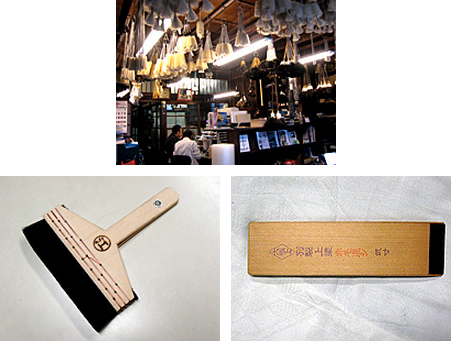 |
こんにちは。セインさん。今日は日本橋大伝馬町にある「江戸屋」にお邪魔します。大伝馬町はその名前が表すように、江戸時代には駅伝、運送・物流の拠点となった街で、やがて木綿を取り扱う伊勢(現在の三重県)の商人をはじめとして家康公ゆかりの国々から商人を集めて、物資の集散地としても賑わったところです。 Hi Thayne-san! Today we’ll be going to Edoya, in Odenmacho, Nihonbashi. During the Edo Period, as the name Odenmacho suggests, this area was a hub for horse messengers and the transport and distribution of goods. In time, silk merchants from Ise (present-day Mie Prefecture) and other merchants doing business with the Edo government gathered here from the provinces, and it became a major trading center.
江戸屋はこの地で、享保3年(1718)に創業したハケ(刷毛)の老舗。今日は12代目のご主人にお話をうかがいます。 |
|
|
| (濵田) |
ようこそ、セインさん。濵田です。 Thayne-san, welcome. I’m Hamada. |
|
|
 |
こんにちは、濵田さん。よろしくお願いします。ところで、このお店、とってもすてきなビルですね。 Hi Hamada-san, pleased to meet you. Your shop is really beautiful, by the way. |
|
|
| (濵田) |
ありがとうございます。でも、ビルのように見えるのは外観だけで、中は木造の2階建てなんです。 Thank you. But what you see from here is only the building’s facade. The inside is actually a two-story wooden building. |
|
|
|
 |
|
店舗外観。一見、洋館風の建物は、関東大震災後に東京でブームになった「看板建築」と呼ばれる建築スタイル。木造家屋の正面に平らな面を取り付けて、モルタルで装飾をあしらっている。縦線を強調したデザインは、ハケをかたどっていると伝わる。 The shop as viewed from the street. At first glance, the building seems to be Western, but the architectural style is called kanban kenchiku(signboard architecture), popular in Tokyo after the Great Kanto Earthquake. The front of the building is covered with mortar and a flat facade is attached as decoration. This design, with its emphasis on vertical lines, is said to symbolize brushstrokes. |
|
|
 |
なるほど、中に入ると立派な木造家屋ですね。 お店に入るまでのエントランスも情緒たっぷりで、素敵なお店ですね。 I see, so the inside is a magnificent wooden building. |
|
|
| (濵田) |
昔は、1階が仕上げの作業場を備えた売り場、2階には職人さんが住んでいたんです。 In the old days, the ground floor held both a workshop where the final steps of making the brushes were completed, and a shop where they were sold, and the second floor was where the craftsmen lived. |
|
|
 |
お店の天井いっぱいにハケがぶら下がっているディスプレイが、とってもユニークですね。ハケは何種類くらい取り扱っているんですか? Displaying your brushes by hanging them from every corner of the ceiling is really unique. About how many types of brushes do you carry? |
|
|
|
 |
|
|
| (濵田) |
ハケとブラシを合わせて3千種類以上はあると思います。ハケだけでも、ふすまや屏風の紙を貼る際に使うもの、漆器に漆を塗るためのもの、友禅などの布の染色に使うもの、ペンキやニスなどを塗るもの、歌舞伎役者が水おしろいを顔に伸ばす時に使う化粧用など、様々な用途に応える商品が必要で、その中でさらに形の違いや大小、毛の長短、質の違いなどが、細かく求められますから。この店のお客様は、物づくりの人たち。私たちはそうした職人さんの使う道具を作り、売っているわけです。 Counting both Japanese hake brushes and Western brushes, I think we have over 3,000 kinds. We have customers looking for hake brushes for painting lacquer ware, for dyeing cloth and yuzen, and for Kabuki actors who need brushes to apply their white make-up foundation. For each use, we have various shapes, sizes, lengths, and qualities. Our customers are artisans, and we make and sell the tools they need to practice their craft. |
|
|
 |
なるほど! これまでいろいろな老舗を訪ねて、素晴らしい製品を見てきましたが、そうしたものの中にも、この店のハケが使われていたかもしれないということですね。 Is that right! We’ve visited lots of old shops and seen some really beautiful things. Some of them may have been made with brushes from this shop! |
|
|
| (濵田) |
はい。いい物を作るには、いい道具が必要なんです。 That’s right. You need quality tools to make a quality product. |
|
|
 |
素晴らしい。 That’s wonderful. |
|
|
| (濵田) |
ですから、一つひとつの商品を丁寧に、誠実に作っています。そうすると、職人さんたちも大事に使ってくれます。さらに職人さんが、自分が使いやすいように、大きさや形、毛の質や量、握り具合などのリクエストをされる特注品を作ることも多いですし、手になじんだ道具は使いやすいですから、修理も多いんです。 Each and every brush we sell is made carefully and conscientiously. So the craftspeople who use our brushes also take good care of them. We also make a lot of custom-ordered brushes. We get requests for particular sizes and shapes, hair quality and volume, and handle grip. Since it’s easier for artisans to use tools they’re familiar with, we also do a lot of repairs. |
|
|
 |
日本の職人さんの仕事のすばらしさにはいつも感動していましたが、その職人さんが使う道具を作っている職人さんが、さらにその後ろにいたんだ。当たり前のことなのに、いま、そのことに気がつきました。 I’m always impressed with the skill of Japanese craftspeople, but it’s interesting to think that there are people like yourself working behind the scenes, making the tools that the others use. It’s obvious, I know, but I’ve never thought about it until now. |
|
|
| (濵田) |
お客様からのどんな難しいリクエストに応える、というのが、うちの誇りなんです。そして、そこにこそ、うちの価値があると思っています。ですから、少量・多品種なんです。 We’re proud of the fact that we can handle all kinds of custom orders from customers, no matter how challenging. That’s really where our value lies. We’re low-volume, but we handle hundreds of products. |
|
|
 |
ハケやブラシだけじゃなくて、関連商品をどんどん取り扱ったら儲かると考えがちですが、この店のポリシーは違うところにあったんですね。 We tend to think that the more products you sell the more money you make, but your shop has a different philosophy. |
|
|
| (濵田) |
はい。たとえば、木で動物の毛を挟んで釘で留めればハケのような物はできますが、よいハケは、毛を桜の木の皮で包み、サビが出ない竹釘で留めています。もちろん、その竹釘も、竹を削って1本1本作るわけです。こうした知恵と技を絶やすわけにはいきませんし、ただ守るだけじゃなくてさらに進化もしていかなければなりません。ですから、あれもこれも追いかけず、ハケとブラシ一筋に、深く、まじめにやっていくというのが、うちの姿勢なんです。 That’s right. You can make a brush by attaching animal hair to a piece of wood with nails, but in order to make a good brush, we wrap the hair with cherry bark, and secure it with bamboo pegs, which won’t rust. We also cut out each bamboo peg ourselves, of course. We can’t let this knowledge and technique disappear, but we can’t stop at preserving the traditional methods–we also have to evolve. As such, our business principle is to focus single-mindedly on hake and other brushes rather than chasing after every new business possibility. |
|
|
 |
とても感動しました。実は、僕はこの店は初めてじゃなくて、前にたまたま通りかかって、タワシを買ったことがあるんです。とっても使い心地がよくて、おまけに丈夫なんです。そのあたりで買ったものとは全然違うんです。 That’s very impressive. Actually, this is not my first time to visit your shop; I just happened to be passing by here one time and stopped in to look and bought a tawashi brush. It feels great to hold, and it’s very durable as well. Other brushes just can’t compare to it. |
|
|
| (濵田) |
そうでしたか。ありがとうございます。うちのタワシは本当に丈夫なんですよ。お蕎麦屋さんが、「毎日、何十回・何百回と、タワシでザルを力いっぱい洗っているけど毛が抜けたり、へたったりしない」と言ってくれますから。 Well, thank you very much. Yes, our tawashi brushes hold up really well. One soba shop has told us they use our tawashi to wash their zaru vigorously dozens or even hundreds of times a day, every day, and the fibers don’t fall out or lose their effectiveness at all. |
|
|
 |
そうなんです。だから、何度も買い替えに来れなくてごめんなさい(笑)。 I agree. So I have to apologize that I haven’t needed to come back for a replacement! |
|
|
|
  |
|
|
|
|
 |
江戸屋さんは、洋服ブラシやヘアーブラシ、靴ブラシから歯ブラシまでありますから、タワシ以外もぜひ、ご愛用ください(笑)。 それから、大伝馬町には宝田恵比寿神社という商売繁盛にご利益のあるお社があって、毎年10月19日・20日の例大祭では「べったら市」という江戸時代からの縁日も開かれます。大根の麹漬け「べったら漬け」の屋台のほか、たくさんの屋台が出て大賑わいになりますから、来年はぜひご一緒しましょう。 Edoya also makes brushes for clothes and shoes, hairbrushes, and toothbrushes, so you can try those out as well! One more thing―in Odenmacho there’s a shrine called Takarada Ebisu Shrine that brings business prosperity, and every year on October 19 and 20 is the Bettara Ichi, a temple festival that has been held since the Edo Period. There are lots of food stalls, including bettara pickled daikon radish, and lots of people turn out. Next year we should go together! |
|
|
  |
ぜひ!! 濱田さん、今日はありがとうございました。 That would be great! Hamada-san, thank you very much for your time today. |
|
 |
|
(文)太田美代 (英訳)デイビッド・A・セイン |
 1959年、米国生まれ。証券会社勤務を経て来日し、翻訳・通訳など多岐にわたって活躍。豊富な教授経験を生かし、数多くの英語関係書籍を執筆。近著に『日本人のチョットへんな英語』(アスコム)、『超入門シャドーイング』(主婦の友社)、日本人が使いすぎる英語(PHP文庫)など多数。 下町の魅力に魅了され、自身が代表を務める英語関連のコンテンツ会社のエートゥーゼットのオフィスを根津に構えている。英会話本の執筆をしながら、東京・文京区根津と春日にあるエートゥーゼット英語学校の校長も務める。 http://www.smartenglish.co.jp/
1959年、米国生まれ。証券会社勤務を経て来日し、翻訳・通訳など多岐にわたって活躍。豊富な教授経験を生かし、数多くの英語関係書籍を執筆。近著に『日本人のチョットへんな英語』(アスコム)、『超入門シャドーイング』(主婦の友社)、日本人が使いすぎる英語(PHP文庫)など多数。 下町の魅力に魅了され、自身が代表を務める英語関連のコンテンツ会社のエートゥーゼットのオフィスを根津に構えている。英会話本の執筆をしながら、東京・文京区根津と春日にあるエートゥーゼット英語学校の校長も務める。 http://www.smartenglish.co.jp/












